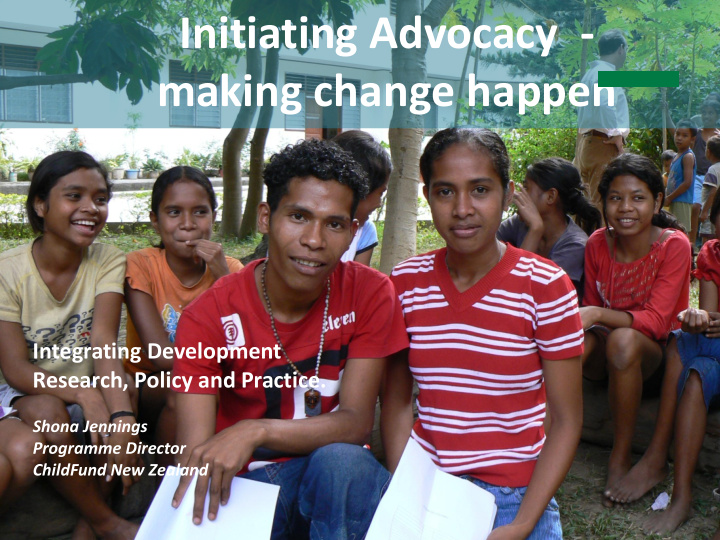



Initiating Advocacy - making change happen Integrating Development Research, Policy and Practice. Shona Jennings Programme Director ChildFund New Zealand
Over the next 15 minutes… • What is Advocacy? • A citizen-action approach • A social justice / international-level campaign • A planning framework • Some useful tools Drawn on experience with ChildFund New Zealand, and as a VSA volunteer with the Eastern Cape NGO Coalition, South Africa.
Citizen-centred advocacy “ Citizen centred advocacy is an organised political process that involves the coordinated efforts of people to change policies, practices, ideas and values that perpetuate inequality, prejudice, and exclusion. It strengthens citizens’ capacity as decision makers and builds more accountable and equitable institutions of power.” ( VeneKlasen and Miller, World Neighbours 2002)
What is advocacy? • Moving from ‘what is’ to what should be’. • It is a series of actions directed at change. • Can be confrontational, but more often it is about seduction and persuasion – bringing people with you. • It is about selling solutions.
Citizen approach: supporting the voiceless to speak for themselves.
Citizen Approach • Citizen power - organising and equipping people to get involved and advocate for change • Influencing decision-makers • Holding authority to account
EXAMPLE Improving toilets in an informal settlement
Tell people‟s stories. Make it real. Make the „ask‟ clear.
What they achieved • 10 new toilet blocks • Improved maintenance • Engaged & informed residents, ready to campaign again (housing, water, healthcare…)
Social justice • A national/international advocacy campaign seeks to change policy to improve laws and policies (e.g. UN & governments)
Two-way approach • Even at the international level, advocacy should directly involve the poor. • To make significant change at the micro-level, you also need to influence macro- level policy and regulatory frameworks.
EXAMPLE: HIV & AIDS – local to international • Local Women and Youth HIV & AIDS Support Groups lobby at local level. • Identify and motivate for HIV & AIDS issues in communities. • Unite with national coalitions to advocate across local, national, international levels.
Example: Access to ARVs • Only half people who need ARVs in SA have access to them. • Poor supplies. Local: pressure on Provincial authorities. • National/International : Trade Related Aspects of Intellectual Property Rights agreement enforced - pharmaceutical companies forced to drastically reduce price.
Empowerment value (youth) “We will be able to state our demands. There‟s strength in unity…but things won‟t happen overnight.” “We need to ensure young people participate in social issues. Youth look at us as role models.” “Youth are interested but need opportunities to come together – they need to know what doors to knock on!” “We can access municipalities and departments. We CAN voice ideas.”
The how-to part
FRAMEWORK: SETTING OUT TO WIN Get Go Get set ready Roll-out a well Consolidate Shore up thought-through supporters; reasoning; communication define the gather data, Review and action plan problem, and facts, research; targeting the what the solution know the people that should be. system; identify need to be and bring on influenced. board all the assets available.
Get ready • Form the team. Who’s on -board. • What’s the problem? Define and understand it! • What’s the solution? Define. Have a clear, measurable goal. • Develop the compelling, one minute message – statement + evidence + example + action desired. Short, sweet and easy to understand. Repeat. Repeat. Repeat.
Get set – map it • Where’s the proof/evidence/stories? Gather. • Who is responsible for change? By when? Develop a policy/decision-making map to identify policy and change-making process – how it works on paper and in real life. What moves decision-makers; how? Find common ground. • What resources are available/needed? What are the assets – use the head, hand, heart, hip exercise (slide 23).
Go • Select channels of communication to match the target audience. People need to ‘buy’ the idea. Sell. Seduce. Sometimes… fight! • Learn from others. Link. Build campaigns and initiatives on tested, well-honed strategies. • Educate, motivate, mobilise – make the case for why, and why now!
Review/revise • Set result targets against steps towards change, rather than actual change (which is complex and may take time) • Not achieving end goal does not mean no progress. • Policy change is a means to the goal of broader social change – hard to measure. • Stories often more telling than numbers.
1. When choosing an issue … (In no particular order) • Is it a widely felt problem? • Is it consistent with our mission and vision? • Will it respond to expressed needs of the communities we’re working with? • Will it result in real improvement to people’s lives? • Will it have broad support of people across all levels? • Will it be easily understood? (and tap into ‘heart - space’) • Can we provide sound data around the problem/solution? • Is it achievable? • Will it help strengthen our relationships with other groups/NGOs working towards common goals? • Does it have a clear time frame? • Will it empower communities in advocacy/change-making?
2. Invest in building evidence/stories • Communities and activists need to do the analysis and reflection themselves. “They respect results more when they have a hand in doing the research.” • Motivate people to act. Build confidence. • People only have credibility if they are doing what it is they’re advocating for.
3. Asset inventory – what we have; what we should seek HIP: HEAD: HAND: HEART: Connections Knowledge, Resources Values (allies, Expertise (physical, (rights, influencers) technical, cultural financial) systems, beliefs) (An asset-based community development tool (Coady Institute) – use to identify resources within a community that can be used for advocacy)
In conclusion Advocacy is an action directed at change. It is putting a problem on the agenda, providing a solution to that problem, building support for that solution and for the action necessary to implement that solution.
Thank You Great resources: http://www.fenton.com/FENTON_IndustryGuide_NowHearThis.pdf www.intrac.org/.../INTRAC-Advocacy-and-Campaigning-Toolkit.pd... Shona Jennings Ph 09 966 0869 shona@childfund.org.nz
Recommend
More recommend